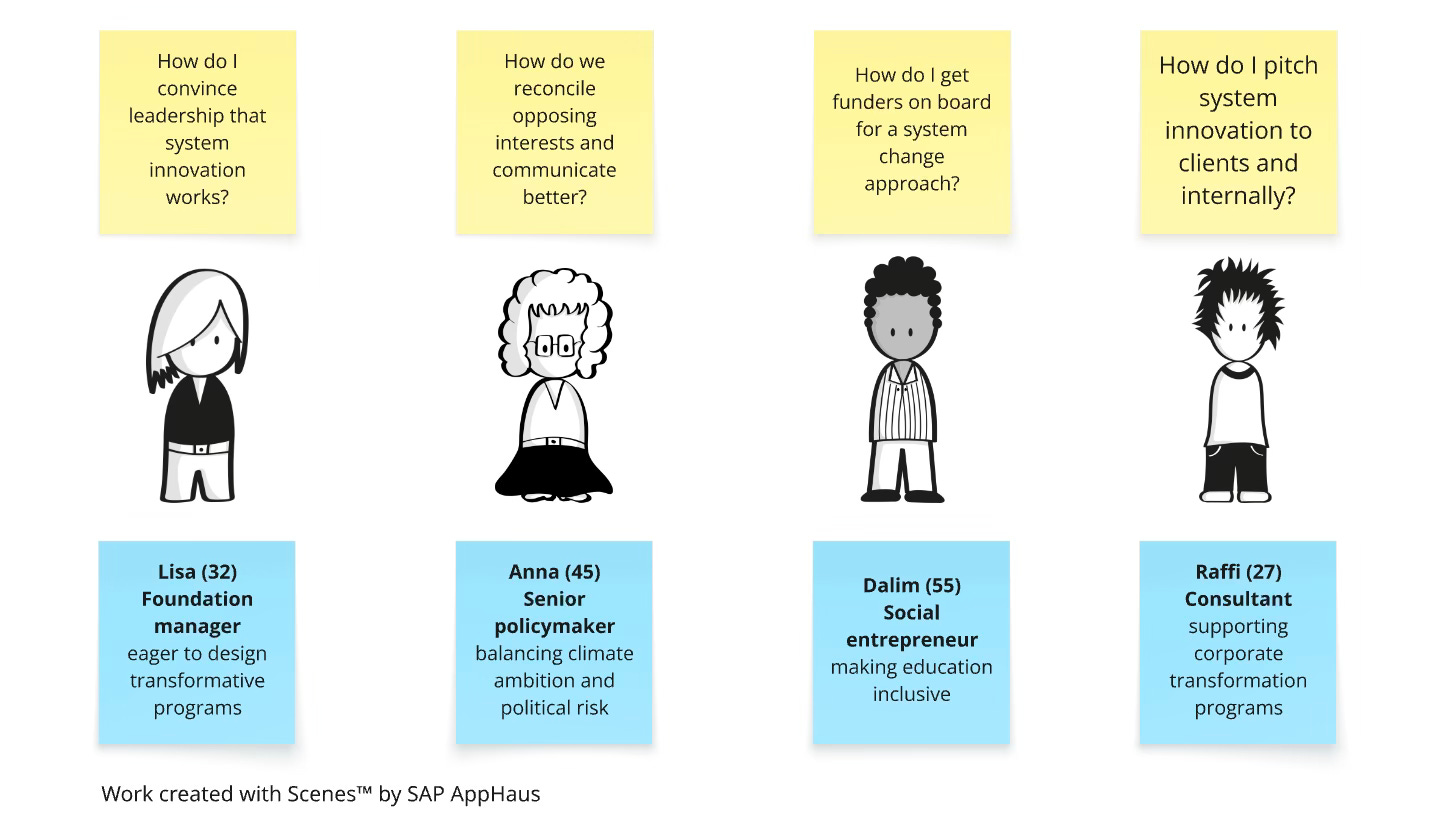Who can change systems?
Are you working for a foundation, public agency, or NGO seeking transformative change? Or are you facilitating system innovation processes? Then join this co-creation process and learn with peers!
The insights in our emerging system innovation book are relevant for anyone who wants to spark change together with others – whether on a small or large scale. Since we focus on methods it will be most useful for people in charge of designing and implementing programs that bring multiple players together for systemic change.
For example:
Foundations and donors developing calls for proposals or programmatic approaches to change certain systems
Ministries and other public agencies that chart pathways toward new (mobility, energy, health etc) systems and aim to involve relevant stakeholders along the way
NGOs and development organizations that design and implement more sustainable, locally grounded and transformative projects
Facilitators, experts and consultants who support these actors in setting up, running and evaluating system change initiatives
We capture these profiles in four personas to give you a sense of who this book is for.
If you see yourself in one of these stories, this book co-creation process is for you. It’s your invitation to explore practical methods, learn with peers, and add your own insight and experience.
Lisa, 32, lives in Amsterdam. She’s just started a new role at a foundation supporting regenerative agriculture. Passionate about food and farming, Lisa is excited to work with farmers and startups – but also feels the pressure. Leadership expects “transformative” programs, and previous proposals were rejected as not ambitious enough. She’s explored system innovation and wants to design a program around it.
Lisa is asking:
How do I convince leadership that this approach works?
What evidence and examples can I share?
How do I run a pilot and get others on board?
How do I make the abstract language of system innovation more tangible for my team?
Anna, 45, leads the Energy Division at the Ministry of Economic Affairs in Berlin. She’s responsible for rapidly expanding renewable energy to help meet climate targets. Her team is motivated but unsure how to balance ambitious goals with political realities. Risks are not an option – the media scrutinizes every move.
Anna is wondering:
How can we create more productive stakeholder dialogues?
Is it possible to bridge seemingly opposing interests?
How do we generate better policy options and minimize risks?
How can we build trust and communicate solutions effectively?
Dalim, 55, is a social entrepreneur in Bangladesh. As a father of three, he’s passionate about making education more inclusive and wants to influence government systems. Drafting a new grant proposal, he finds system innovation ideas exciting but wonders how to apply them.
Dalim asks:
Who should I partner with and how?
How do I persuade donors about this new approach?
How can we include policymakers and create space for experimentation?
How do we measure progress and adapt along the way?
Raffi, 27, works at a global consulting firm. He is eager to try something new – approaches that are cool, innovative, and deliver real impact. Inspired by his year of voluntary service in Colombia, Raffi wants to bring system change thinking into his team’s work.
Raffi wonders:
How do I pitch system innovation to colleagues and clients?
What data and stories prove its effectiveness?
How can we test it in small ways and make it fit our culture?
Why is system innovation relevant for the organizations behind these personas? What is the main rationale for taking a transformative approach?
Lisa’s foundation exists to solve societal problems. But the team is realizing that treating symptoms isn’t enough. To create lasting change, they need to address the root causes of these challenges. It’s a promising but demanding path: working systemically requires new ways of partnering, measuring impact, and fostering continuous learning and adaptation.
Anna’s ministry is under pressure to deliver solutions that people actually want and that are feasible to implement – all while boosting competitiveness and achieving social goals. By involving stakeholders in shaping solutions, the ministry can build proposals they support and help to implement. This not only increases the chances of success, but also strengthens trust in democratic governments and parties.
Dalim’s NGO in Bangladesh is seeking more sustainable answers to local challenges. Yet, financing long-term, preventative, and complex interventions is tough. Many donors still prioritize quick wins and countable results. On top of that, collaboration with government and business is often met with skepticism. But if Dalim can inspire other players to embrace a systemic approach, they could overcome these hurdles together.
Raffi’s consulting firm knows that transformation needs to be orchestrated beyond company boundaries. But it’s caught in a dilemma: future markets don’t yet promise enough revenue and profits, while today’s markets are shrinking. Taking responsibility for driving system change is a pioneering move – but one that can give companies more planning security and freedom to shape their future. They can accelerate the transformation they want to see and position themselves as responsible actors and attractive investments.
✨ Why you?
Because system change needs people like you – people willing to think big, start small, and bring others along on the journey.
This isn’t about having all the answers. It’s about asking new questions, testing new approaches, and creating space for transformation to take root.



